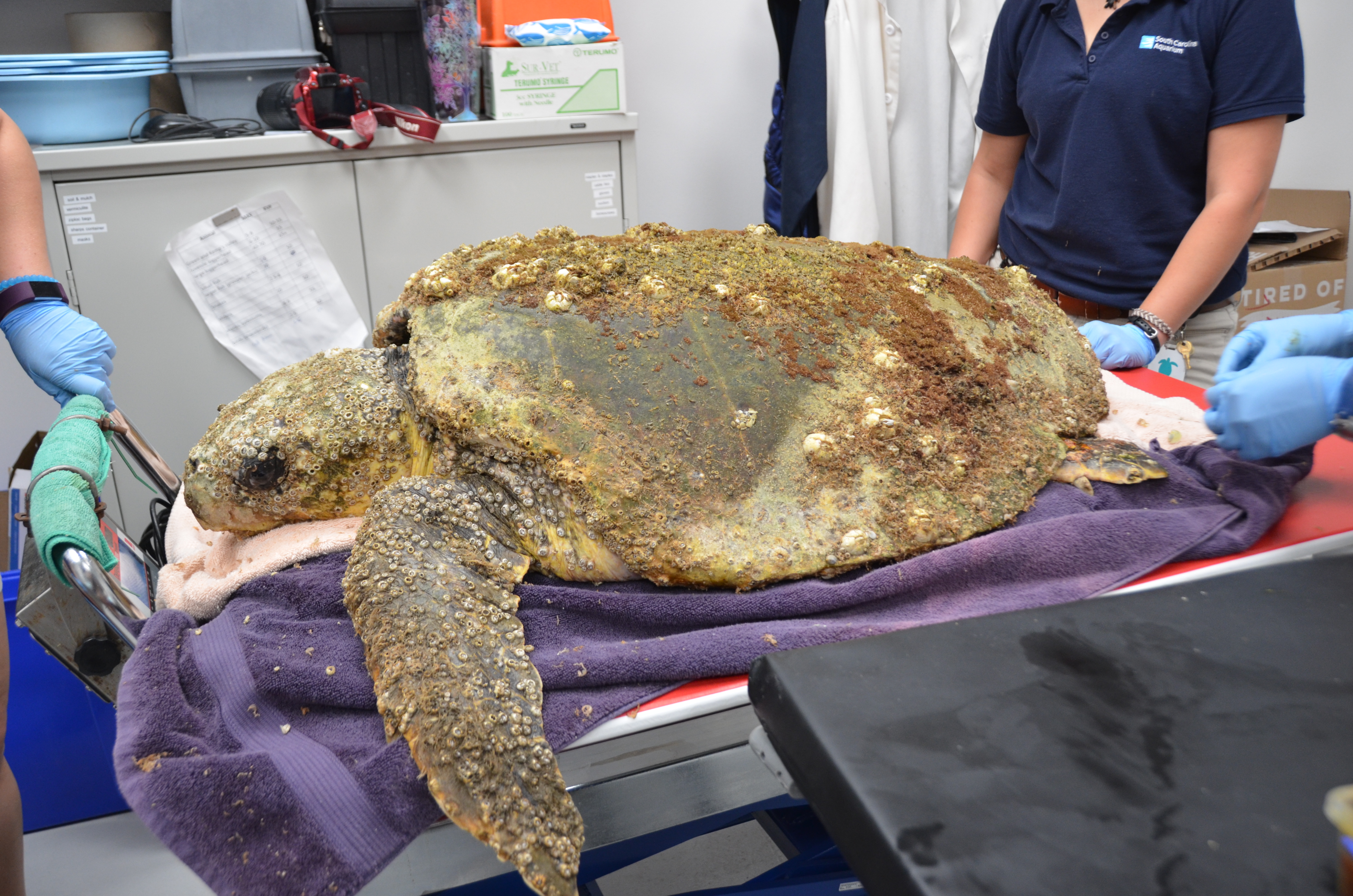Loggerhead (Caretta caretta)
Stranding Location: Tombrook Creek between Edisto and Seabrook Islands, SC
Arrival Date: 4/19/2017
Age: Subadult
Weight: 56.5 kg ( 118 pounds)
Case History
Anchor was found floating at the surface of the water in Tombrook Creek, which is located between Edisto and Seabrook Islands. Anchor appeared to be very lethargic, and had a lot of barnacle and algae growth on the carapace (top shell). Due to “her” appearance, and the fact that she was floating, South Carolina Department of Natural Resources (SCDNR) was contacted and transporters Tyler Harrell, Emma Schultz and Liz Duermit brought this patient to us for further treatment.
Treatment
Anchor’s appearance indicated that she had debilitated turtle syndrome (DTS) characterized by lethargy, emaciation and a heavy epibiont load. The epibiont load was present on her shell, flippers and even on both of her eye lids! Anchor received a thorough exam and a blood draw. Bloodwork results indicated that Anchor was not only dehydrated, but also anemic, which is another issue caused by DTS. The barnacles that were growing on Anchor’s eyelids were carefully removed, and fluid therapy was started. Anchor also had a low glucose (blood sugar) level so fluids with a small amount of sugar were administered subcutaneously (under the skin) along with vitamins. Anchor also received Hetastarch, which was administered intravenously. Hetastarch helps to re-hydrate patients by pulling in fluids and vitamins into the vascular space so they can be circulated through the bloodstream and throughout the body more effectively. Anchor’s heart rate was strong, but on the lower end of a “normal” heart rate for a loggerhead sea turtle. Anchor was also started on an antibiotic regime to help combat any opportunistic secondary infections that can occur because of a lowered immune system. Anchor was set up in a “waterbed” with lots of foam and a small amount of freshwater overnight. Freshwater aids in both re-hydration and in the removal of barnacles and other epibionts on the skin and shell.
Updates
April 25, 2017: Anchor is stable, but is still very weak. Anchor has been moved to a tank with about 2 feet of water because she is not strong enough to be at a deeper water depth. Anchor is being reintroduced to food, and we are gradually increasing her diet. She is also receiving antibiotics and calcium injections weekly. Anchor is slowly responding to supportive care, and we are hoping to see more of an improvement in the next week or two. Due to her debilitated state, her shell is very soft so we are minimizing our handling of her as much as possible. Most treatments are done in her tank so she is more comfortable.
May 5, 2017: Anchor has been slow to respond to supportive care – she is very lethargic and often floats on the surface of her tank. Anchor is currently receiving two antibiotics and calcium injections to help replenish the calcium in her body so her shell can harden up and become stronger. Anchor is also not very interested in food. On a positive note, though she’s more often floating at the top, Anchor has recently been observed resting flat on the bottom of her tank, which is a good sign! We are doing everything we can for Anchor and will continue to provide supportive care. Though Anchor is stable, she is a very debilitated turtle and has a long road to recovery ahead of her.
May 11, 2017: The Sea Turtle Care Center team are sad to report that despite our best efforts Anchor has passed overnight. This turtle came to us severely emaciated with poor blood values and over the past couple weeks received fluids, vitamins, antibiotic injections, IV nutrition and cardiovascular support. Unfortunately, Anchor was not responding to or improving with treatment.




